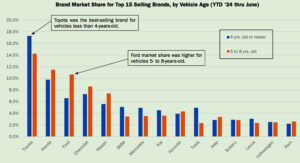Editor’s Note: This commentary was provided by DBRS Morning Star, which rates more than 4,000 issuers and nearly 60,000 securities worldwide.
There are three primary reasons why General Motors, Ford, and Stellantis are unlikely to lose ground as a result of current labor actions
Despite production disruptions, the Detroit 3 — General Motors, Ford, and Stellantis — are unlikely to lose market share as a result of the current labor actions because (1) customers remain loyal to their higher margin core nameplates, (2) supply chain and inventory improvements mean they are able to supply the demanded vehicles, (3) production levels at other original equipment manufacturers (OEMs) are not sufficient to greatly expand sales volumes beyond their current customer demands, and (4) the current sales momentum among the Detroit 3 is strong.
Therefore, in conjunction with our view that financial profiles and liquidity positions remain strong, we reiterate our opinion that negative rating actions against the Detroit 3 stemming directly from the strike are unlikely.
Detroit 3 Market Share Likely Resilient to Strike Effects
With the United Auto Workers (UAW) strike about to conclude its third week, we note that the scale of the strike has progressively increased since its inception on September 15, 2023, when the UAW initially targeted one facility of each of General Motors Company (GM; rated BBB (high) with a Stable trend), Ford Motor Company (Ford; rated BBB (low) with a Stable trend), and Stellantis N.V. (Stellantis; rated BBB (high) with a Stable trend).
While the strike appears likely to drag on and scale up, we note that, absent a truly protracted work stoppage, the Detroit 3 appear unlikely to suffer any material market share losses stemming from the strike.
Strike Expanding — Although Still Far From a Full Strike
Currently, the five assembly plants and 38 distribution centers directly affected by the strike are estimated to represent roughly 17% of the Detroit 3’s North American production — still substantially lower than a full strike.
As we previously indicated (for further details, please refer to our commentary titled UAW Launches Unprecedented Strike Against the Detroit 3, published on September 15, 2023) we are not surprised by the targeted strike actions thus far as these moderate the depletion of the UAW’s strike fund.
Moreover, given the high level of interdependence across assembly/production facilities, work stoppages at strategically selected plants result in production interruptions across additional locations. Thus an estimated several thousand additional factory workers at the Detroit 3 and affected suppliers are currently off the job because of spillover effects from the strike.
Detroit 3 Inventories at Sound Levels
Following the extended production constraints through much of the past three years, we note that the global semiconductor shortage — while continuing to affect production volumes — has nonetheless noticeably improved in 2023, enabling OEMs to somewhat replenish their inventories.
As of the beginning of the strike, total industry inventories were estimated at approximately 2 million units, roughly 800,000 units more than a year ago. In days’ supply terms, this translates to a regional industry average of 57 days.
GM’s days’ supply is in line with the industry average, with those of Ford and Stellantis exceeding 80 days and 100 days, respectively. While certain isolated models have considerably lower inventories and could face tight supplies over the coming weeks, in aggregate terms the Detroit 3 entered the strike amid rather sound inventory levels.
Detroit 3 Enjoy Strong Customer Loyalty to Key Models
Further to the Detroit 3 inventories referenced above, we note that the North American auto manufacturers enjoy strong customer loyalty to their key models, significantly concentrated within the sport-utility vehicle (SUV) and pick-up truck segments.
These models have historically provided sizable contribution margins for the Detroit 3 that have in turn prompted these OEMs to allocate substantial investments in product development over several model generations to help defend this profitable territory.
The U.S. pick-up truck market in particular is dominated by the Detroit 3, which collectively represent well more than 80% of regional segment sales. As such, other OEMs are unlikely to sway potential purchasers toward their models and away from the highly established product offerings of the Detroit 3, even in the scenario of a lengthy strike.
Ongoing Production Constraints Further Limit Potential Market Share Losses
Moreover, despite the improvement in the global semiconductor shortage and other supply chain challenges, we note that overall production capabilities have not reverted to levels that would enable a given OEM to not only satisfy demand (including ongoing pent-up demand) for its own core models, but also attain meaningful conquest sales at the expense of a competitor.
This therefore effectively represents another obstacle for other OEMs in taking away meaningful market share from the Detroit 3 during the strike.
U.S. Auto Sales Trending Positively — Rating Changes Remain Unlikely
We note that auto sales in the Detroit 3’s core U.S. market are trending positively this year, with pent-up demand and higher production volumes more than offsetting rising interest rates and inflationary pressures.
Accordingly, industry profitability has exceeded consensus expectations, with consumers, for the time being, proving more resilient to the current economic headwinds than anticipated. Through the first three quarters of 2023, GM and Ford attained sales increases of 19% and 9%, respectively, compared with the same prior year period, while Stellantis’ regional sales declined nominally by 1%.
For the full year, U.S. industry sales are expected to approach 15.4 million units, which would represent an increase of 1.5 million units, or 10.8%, over 2022 sales levels.
As noted in our previous UAW strike commentaries, we do not currently anticipate the strike resulting in any negative rating actions being taken against the Detroit 3. Financial profiles and liquidity positions remain strong and Ford and GM have secured additional credit lines of $4 billion and $6 billion, respectively, in response to the strike. Thus, the Detroit 3 are prepared to absorb any cash burn stemming from the strike.




Comments are closed.